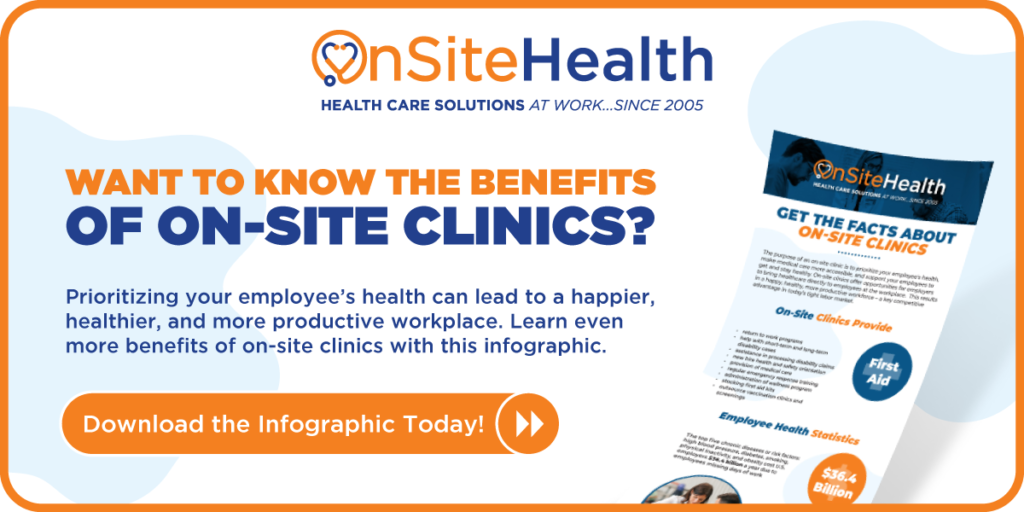Whether an employee is filing paperwork on a computer or handling heavy machinery, clear vision is essential for efficiency, productivity, and safety in the workplace. According to the CDC, uncorrected vision issues such as blurred vision cost the global economy an estimated $225 billion in lost productivity and absenteeism. While employers may think vision problems only affect the individual, when left untreated, these issues could have a drastic impact on your organization.
Interested in Health Screenings for Your Employees?
Learn More About the Benefits
Common Workplace Vision Problems
From eye strain and fatigue to trauma and minor injuries, when employees cannot see well, they cannot perform well. Here are just some of the common vision problems that may be affecting your workforce:
Eye Strain
In the past year, with remote working becoming a norm for many companies, more time in front of computer screens has brought increased cases of eye strain. Eye strain can occur when reading up-close, focusing on screens for prolonged periods of time, or when the eye tries to adjust to bright lights. While some employees may take frequent breaks throughout the day to rest their eyes, this does not directly address the issue at hand. When left untreated, muscle fatigue from eye strain can cause blurred vision.
Dry Eyes
Red, irritated eyes, and blurry vision are symptomatic of dry eyes. Dry eyes occur when your eyes do not make enough tears to keep them moist and to flush away dust. While dry eyes are more common for those who work in office settings, dry eyes can affect anyone.
Headaches
Like eye strain and dry eyes, headaches due to vision problems can lead to difficulty concentrating on the job. These headaches are often caused by poor lighting and screen glare. According to the National Headache Foundation, headaches cost the nation $17 billion in absenteeism, lost productivity, and medical expenses. The Foundation also reports that although 90% of employees say headaches affect their performance, only 33% tell their employers, indicating that this is a potentially bigger issue than employers realize.
Eye Injuries
With an estimated 300,000 eye injuries occurring in the workplace each year, taking preventive measures to protect your sight is critical. 90% of serious eye injuries can be avoided by wearing protective gear such as safety glasses, goggles, or helmets. In addition to ensuring that your employees have the proper eye protection, take the time to educate your employees about the importance of protective eyewear and what to do in an emergency situation before medical attention arrives.

Self-Care and Treatment Tips
To help alleviate some of the discomfort associated with eye strain, dry eyes, and headaches, consider the following:
- If your environment is very dry, using a humidifier can help bring moisture back into the air.
- Try over-the-counter lubricating eye drops to help keep your eyes moist.
- Take breaks and look away from the screen. Focusing on an object in the distance will also allow your eyes to readjust.
- Keep your body hydrated by drinking 8-10 glasses of water per day.
- Consider switching from contact lenses to glasses to help prevent air from blowing directly into your eyes.
- Wear blue-light glasses when working on a computer for prolonged periods of time.
- Blink often to refresh your eyes.
- Adjust the lighting in your room to reduce glare. If possible, try angling your computer away from lights and windows.
Prevent Vision Problems with Regular Screenings
Four out of five adults need some form of vision correction in their lifetime. Whether it’s trouble seeing up close, blurry vision, or a combination of any of the problems listed above, when left untreated these issues can negatively impact health and overall well-being. To help your employees understand the current state of their vision, consider implementing on-site vision screenings. Performed by an OnSite Health medical professional, a vision screening will highlight any potential vision problems as well as the next steps, including a referral to an optometrist if necessary.
As your company’s greatest asset, employee health is a priority. To learn more about OnSite Health’s on-site health clinics and/or staffing a nurse, contact us today. We also accept Anthem insurance for services provided.

